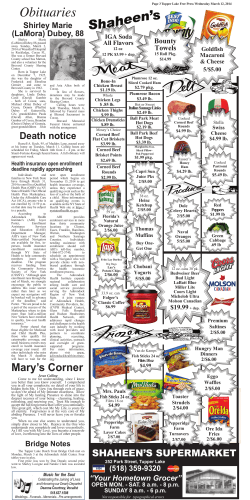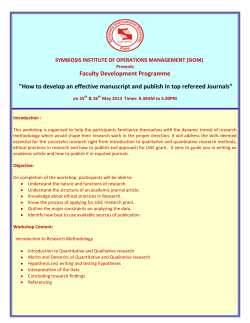
Article
Current Research in Environmental & Applied Mycology 4 (2): 211–216 (2014) ISSN 2229-2225 www.creamjournal.org Article Copyright © 2014 CREAM Online Edition Doi 10.5943/cream/4/2/8 Goosiomyces bambusicola - A new cheirosporous anamorphic species from Western Ghats, India. Dubey R and Neelima AM Dubey R, Neelima AM 2014 – Goosiomyces bambusicola - A new cheirosporous anamorphic species from Western Ghats, India. Current Research in Environmental & Applied Mycology 4(2), 211–216, Doi 10.5943/cream/4/2/8 Abstract A new hyphomycete species, belonging to genus Goosiomyces, i.e. Goosiomyces bambusicola, is taxonomically described and illustrated from India. It is characterized by branched; very long conidiophores, discrete conidiogenous cells, holoblastic conidiogenesis and smooth, cheiroid conidia. It can be easily differentiated from the type species G. digitatus, by variation in the dimensions and branching pattern of conidiophores and smooth conidia. Key words – Bambusa − fungal diversity − long conidiophores − new species − smooth conidia − taxonomy Introduction The Western Ghats of India represent some of the best non-equatorial, tropical evergreen forests in the world. Located along the west coast of India, these steep escarpments are rich in biodiversity and have the distinction of being declared as one of the 34 global biodiversity hotspots (Meyers et al. 2000). Studies on microfungi and fungal biodiversity of different microhabitats in the Western Ghats are also conducted by the Botanical Survey of India (Dubey & Moonambeth 2013 a, b, c). During a fungal biodiversity expedition in the Western Ghats region of Maharashtra, India, conducted in January 2013, an undescribed dematiaceous hyphomycete was found on stems and petioles of Bambusa arundinacea (Retz.) Willd. The fungus produces cheiroid conidia on conidiophores and detailed morphological studies confirmed that it is a hitherto unknown species of Goosiomyces Rao & Manoharachary. The genus Goosiomyces, was established by Rao & Manoharachary in 1989 with G. digitatus Rao & Manoharachary as type species. Perusal of relevant literature reveals that the genus is monotypic (Annonymous 1989 – 2014) characterized by pale brown, septate, irregularly branched hyphae; simple or branched, macronematous, mononematous, erect, straight or flexuous, smooth, septate, reddish brown conidiophores; discrete conidiogenous cells, holoblastic, solitary, dry, lateral, cheiroid, branched, septate, constricted, olivaceous and verrucose conidia (Rao & Manoharachary, 1989) Materials and methods The fungal samples were brought to the laboratory in zip-lock plastic bags. Tease mounts were made in distilled water and lactic acid and cotton blue solution. Measurements of the conidiophores and conidia were made of the material mounted in distilled water. Photomicrographs Submitted 11 June 2014, Accepted 1 October 2014, Published online 23 October 2014 Corresponding Author: Rashmi Dubey – e-mail – [email protected] 211 Figs 1 ̶ 11 – Goosiomyces bambusicola sp.nov. 1 Colonies. 2 ̶ 5 Mature conidia and conidiophores. 6 Branching pattern of conidiophores. 7 ̶ 9 Conidia. 10, 11 Colonies on host surface. (Bar 1, 2 = 100 µm; 3 ̶ 9 = 20 µm). were made using a digital color CCD Camera (Nikon DS Fi1) attached to a Nikon eclipse 50i microscope with interference optics. The type specimen (holotype) is deposited in Ajrekar Mycological Herbarium, Pune (AMH), India. Descriptions and nomenclatural details are deposited in MycoBank. Taxonomy Goosiomyces bambusicola Rashmi Dubey and Neelima sp.nov Figs 1–17 MycoBank: MB809042. Etymology − species named after the name of host plant (Bambusa arundinacea (Retz.) Willd.) on which it is reported. 212 Figs 12–16 – Scanning Electron Microscope (SEM) images of Goosiomyces bambusicola sp.nov. (Holotype). 12 Colony. 13, 14 Conidia and conidiophores. 15 Conidiogenesis. 16 Smooth surface of conidia. Colonies on host surface, discrete, effuse velvety, brown to reddish brown. Mycelium mostly immersed, partly superficial, composed of pale brown, smooth, irregularly branched, smooth hyphae 1.9 ̶ 4.0 µm wide. Conidiophores macronematous, mononematous, very long, up to 1200 µm long, 5 ̶ 8 µm wide, straight or flexuous, septate, often branched, with simple, bifurcate or trifurcate branches arising laterally or apically from the main hyphae, smooth, thick-walled, brown, terminating into hyaline apex. Conidiogenous cells integrated to discrete, terminal and intercalary, holoblastic. Conidia solitary, sometimes in fascicles, smooth, dry, produced laterally or rarely apically, cheiroid, branched, multicellular, brown, 40 ̶ 60 µm long and 30 ̶ 45 µm wide; with basal cell 12 ̶ 18 µm long and 4.0 ̶ 5.5 µm wide. Fig. 17 ̶ Camera lucida drawings. a ̶ c Branching patterns in conidiophores. d,e Conidiogenesis. f Smooth conidia (Bar ̶ 50µm). Sexual state – Unknown. Known distribution – Reported in the natural forest of southern and western parts of India. Material examined – India: Maharashtra, Ratnagiri, Kurne Lanja, on stems and petioles of Bambusa arundinacea (Retz.) Willd, 24 Jan13, Rashmi Dubey, B.S.I. (W.C) 200989 (Ajrekar Mycological Herbarium, AMH 9661, holotype). 214 Discussion The monotypic genus Goosiomyces, typified by G. digitatus, superficially resembles to several other genera with cheiroid or digitate conidia, viz. Sirosporoium Karst. (synonym of Chelisporium Speg.), Cheiroconium v. Hohn., Cheiromycella v.Hohn, Cheiromyces Berk. & Curtis and Digitodesmium Kirk (Ellis 1971, 1976, Carmichael et al 1980, Sutton 1985). The most distinguishing character differentiating Goosiomyces from other genera is that Sirosporoium and Cheiroconium are coelomycetous fungi, whereas Cheiromyces, Cheiromycella and Digitodesmium are hyphomycetes and possess sporodochial fruiting body. Rao & Manoharachary, 1989 noticed all these differences when they established the genus Goosiomyces. Goosiomyces bambusicola is differentiated from G. digitatus by its long conidiophores (up to 1200µm), branching patterns of conidiophores and smooth conidia (Table 1). Table 1 Comparative account Goosiomyces digitatus and G.bambusicola sp.nov. S.No. Morphotaxonomic characters Goosiomyces digitatus Rao& Manoharachary, 1989 1. Colonies Punctiform, discrete, reddish brown to Discrete, effuse, velvety, brown to reddish brown. 2. Conidiophores Simple or rarely branched, up to 300 µm long and 5.5–8.5 µm wide. 3. Conidia Holoblastic, solitary, produced laterally, branched, olivaceous brown, verruculose, 35–50 × 25–36 µm, basal cell 4–5.5 µm wide. Generally branched, branching bifurcate or trifurcate, up to 1200 µm long and 5–8 µm wide. Holoblastic, solitary or sometimes in fascicle, produced laterally or sometimes apically, smooth, 40–60 × 35–40 µm, basal cell 12–18 × 4–5.5 µm. brown Goosiomyces bambusicola Rashmi Dubey and Neelima sp. nov. Acknowledgements Authors are thankful to the Director, Botanical survey of India, for providing all facilities. They are also grateful to the Head of the office, Botanical Survey of India, Western Regional Centre, Pune, for his kind support and encouragement. Ministry of Environment and Forest, New Delhi, is thankfully acknowledged for financial assistance. References Anonymous. 1989–2014 − Fungal Database Nomenclature and species identification. MycoBank. http://www.mycobank.org/Goosiomyces (Accessed on 25.5.2014). Carmichael JW, Kendrick WB, Conners IL and Sigler L. 1980. Genera of Hyphomycetes. Edmonton. The University of Alberta Pr. Alberta, Canada. Dubey R, Moonnambeth NA. 2013a – Kamalomyces mahabaleshwarensis sp. nov. (Tubeufiaceae) from the Western Ghats, India − Mycosphere 4, 760–764. Dubey R, Moonnambeth NA. 2013b – Sawantomyces, a new hyphomycete genus from Western Ghats, India. Journal on New Biological Reports 2, 234–237. Dubey R, Moonnambeth NA. 2013c – Custingophora ratnagiriensis sp. nov. A novel species of Custingophora from Konkan, India. NeBIO - An International Journal of Environment and Biodiversity. 4, 31–32. Ellis MB. 1971 – Dematiaceous Hyphomycetes. Commonwealth Mycological Institute, Kew Surrey, England. Ellis MB. 1976 – More Dematiaceous Hyphomycetes. Commonwealth Mycological Institute, Kew, Surrey, England. Meyers N, Mittermeier RA, Mittermeier CG, da Fonseca GAB and Kent J. 2000 – Biodiversity Hotspots for Conservation priorities. Nature 403, 853–858. Rao NK and Manoharachary C.1989 – Goosiomyces, a new genus of dematiaceous hyphomycetes from Andhra Pradesh, India. Mycological Research. 92, 249–251. Sutton BC 1985 – Notes on some Deuteromycetes Genera with cheroid or digitate brown conidia. Proceedings of the Indian Academy of Sciences (Plant Sci.). 94, 229–244. 216
© Copyright 2025












